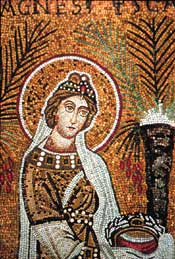Readings:
Psalm 45:11-16
Song of Songs 2:10-13
Matthew 18:1-6Preface of a Saint (3)
PRAYER (traditional wording)
Almighty and everlasting God, who dost choose those whom the world deemeth powerless to put the powerful to shame: Grant us so to cherish the memory of thy youthful martyrs Agnes and Cecilia, that we might share their pure and steadfast faith in thee; through Jesus Christ our Lord, who liveth and reigneth with thee and the Holy Ghost, one God for ever and ever. Amen.
PRAYER (contemporary wording)
Almighty and everlasting God, who chooses those whom the world deems powerless to put the powerful to shame, Grant us so to cherish the memory of your youthful martyrs Agnes and Cecilia, that we might share their pure and steadfast faith in you; through Jesus Christ our Lord, who lives and reigns with you and the Holy Spirit, one God for ever and ever. Amen.
This commoemoration appears in Lesser Feasts & Fasts 2018.
Return to Lectionary Home Page
Webmaster: Charles Wohlers
Last updated: 25 Nov. 2023
AGNES OF ROME
MARTYR (21 JAN 304)
 Agnes
is a Christian martyr who died at Rome around 304 in the persecution
of Diocletian: the last and fiercest of the persecutions of Christianity
by the Roman emperors. The anniversary of her martyrdom is observed
on 21 January. Her name means “pure” in Greek and “lamb”
in Latin. She is said to have been only about twelve or thirteen when
she died, and the remains preserved in St Agnes' Church in Rome are in
agreement with this. It is said that her execution shocked many Romans
and helped bring an end to the persecutions.
Agnes
is a Christian martyr who died at Rome around 304 in the persecution
of Diocletian: the last and fiercest of the persecutions of Christianity
by the Roman emperors. The anniversary of her martyrdom is observed
on 21 January. Her name means “pure” in Greek and “lamb”
in Latin. She is said to have been only about twelve or thirteen when
she died, and the remains preserved in St Agnes' Church in Rome are in
agreement with this. It is said that her execution shocked many Romans
and helped bring an end to the persecutions.
Some said, “It is contrary to Roman law
to put a virgin to death. Our leaders say that it is necessary to kill
Christians in order to preserve the old Roman ways: but they are themselves
scorning those ways in the process.”
Others said, “Do young girls constitute
such a threat to Rome that it is necessary to kill them?”
Others said, “If this religion can enable
a twelve-year-old girl to meet death without fear, it is worth checking
out.”
There is a narrative poem by Keats, called “The Eve of Saint Agnes.” It is a romantic poem with a mediaeval setting, about an elopement the night before St Agnes' Day. The only tie-in with Agnes is that (presumably because she died as a young virgin), Agnes is regarded as the patron of young unmarried girls, and there is a folk-belief that a girl who goes to bed supperless on the eve of St Agnes's Day will dream that night about her husband-to-be.
by James Kiefer
CECILIA OF ROME
MARTYR AT ROME, c. 280
 St. Cecilia, by Guido Reni |
The research of Giovanni Battista de Rossi, however, appears to confirm the statement of Venantius Fortunatus, Bishop of Poitiers (d. 600), that she perished in Sicily under Emperor Marcus Aurelius between 176 and 180.
The martyrdom of Cecilia is said to have followed that of her husband and his brother by the prefect Turcius Almachius. The officers of the prefect then sought to have Cecilia killed as well. At that time, the officials attempted to kill her by boiling her alive. However, the attempt failed, and she was to be beheaded. The executioner attempted to decapitate her three times unsuccessfully, at which time he fled. Cecilia survived another three days before succumbing. In the last three days of her life, she opened her eyes, gazed at her family and friends who crowded around her cell, closed them, and never opened them again. The people by her cell knew immediately that she was to become a saint in heaven.
more at Wikipedia